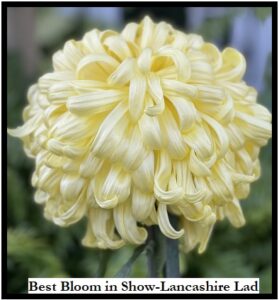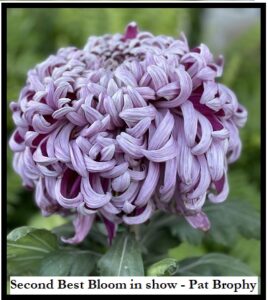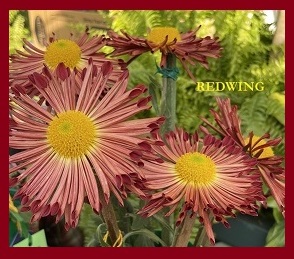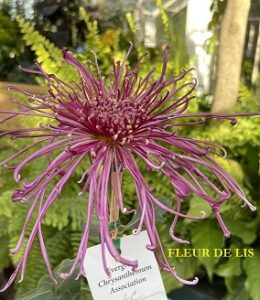Cultural Discussion @ January Meeting: led by Don Stark
Don reviewed activities for Jan and early Feb
Getting Ready:
-Get new shoots growing on last year’s stools, fertilize with Nitrogen Fertilizer i.e. 20-9-20, Blood meal (13-0-0) or other .
Prepare cutting beds and growing areas.
-Clean up, Add some fungicide, Fix temp. controls and overhead lighting
-Dump old cutting bed materials every 3-4 years
My new bed mix: 50% Lane Mountain White (sharp) Sand & 50% M&R mix or Pro Earth #2
-Maintain ambient temperature around the cutting beds at 50 deg F. or higher and set
temperature of cutting beds at 65-70 Deg F.
Gather Supplies:
– M&R mix, Fungicides (Immunox by Spectracide), Cutting tags, B-9 etc
Stark suggested we no longer use Daconil, and that we recommend using Actionivate to
keep our plants free of fungi.
Taking Cuttings:
-Start taking cuttings mid Jan to Mid Feb.—for most #1s, #2s , #3s and Spiders. Also start
cuttings for any specimen plants you plan to grow.
-Cover cuttings for a few days with a plastic dome cover to maintain moisture. After 3 days
remove or raise the cover an inch or so to facilitate air circulation.
– Sprinkle beds and plants every day or so to keep cutting bed lightly moist.
Most of the above pertains to starting our cuttings the old conventional way. Mark Ross discussed the process when using earth pots:
– the earth pots mat of 72 ? small pots need to be placed on a regulated heated surface . This can be the surface of your old cutting bed or on regulated heat pads laid on a hard surface. It will be necessary to spray the cuttings 2-3 times a day for a few days to keep the cuttings moist. We’ll ask Mark for more written data on the subject for the Feb meeting.
Follow up on Ivor Mace Visit:
Stark revisited the Ivor Mace visit of Nov. 29; Thanked Bob Ewing for acquiring the Wesley Gardens hall for the occasion and also extended a special thanks to Chris Brookes for all the coordination and planning needed to bring Ivor here for a visit. After the social occasion Ivor gave a 2 hour discussion on his growing methods etc. The NOTES from this talk are at the end of this post.
OUR REGULAR CULTURAL NOTES FOR FEBRUARY
PLANT CULTURE – Continue to start plants for our public sale in April. Plants must be given protection for the first few months and carefully nurtured to establish strong root systems before potting or repotting. In February, take starts for the early blooming varieties. At this month’s meeting, the focus is growing plants, cultivar selection, materials and your reference books. Cultural recommendations are attached.
SUPPLIES – Supplies to be available at the February meeting.
· Plant Labels, White and Yellow 100 per pack.
· 2½” Plastic planting/starting cubes
· M&R Soilless Growing Media (Need enough orders to buy a pallet for a lower price). The cultural committee has decided to provide only M&R mix. It is a better product for mums than the mix used previously. This mix can be used for all pottings from the first 2 ½” pot to the 9 or 10” final pot.
Contact: Mark Ross or Ronnie Elliott with Supply and Soilless orders.
Novice Handbooks will be available at the next meetings and the Public Plant Sale at a cost of $2.00 (payable to the Treasurer)
FEBRUARY TO DO LIST. (New: 1-28-06 DRS)
Continue with cuttings:
Continue taking cuttings throughout Feb. and into March for some. A few early Feb. cuttings can be available for the March/April Plant sales (March Members sale at the March meeting and the public plant sale on Sat. April 11th). Most Feb. and March cuttings should be of the early English and American varieties. Late Decoratives, Classes 4, 5, 14 and 15) should be started primarily in Feb. Take cuttings for yourself and for the plant sale.
Most varieties in classes 1,2 and 3 should have been started by the end of January: however here are some varieties that can be successfully grown from Feb. cuttings. #1 & #2’s Lundy, Yellow Lundy, David Dando, Ralph Lambert, Yellow Ralph Lambert, Athabaska, Harry Gee, Jane Sharpe and Seychelles. #3’s Len Hall, Salmon, Primrose and yellow Fairweathers, Stockton and Heather James.
Cuttings started directly in the cutting bed media should not require fertilization before potting on. If you are starting in the cross bottom bands or 2” clay pots, fertilizer should be added after 3 to 4 weeks as these cutting generally require 5-6 weeks before potting on. Start fertilizing once a week beginning with the 4th week. Use an early Mum fertilizer, Peters 9-45-15 or Plant Marvel 12-45-10 (One Tsp/Gal once a week)
Potting on:
Most growers are using the soilless M&R potting mix sold by the club. In general no additives are required for the early pottings (2” and 4” pots); however some growers like to add some special ingredients. For instance Alfalfa meal or pellets is a good stimulant that can be added. Avoid adding Bone meal, as you will probably find fungi growing on the top of your pots due to too much potassium.
– Pot the mums directly from the cutting beds into 2” pots, or from the starter bands or pots into 3” or 4” pots.
– Use new pots, or wash previously used pots with a mild bleach solution (Clorox) to kill moss and eliminate the viruses. When bleach is used thoroughly rinse pots in fresh water to get the bleach out of the pot.
– Clay pots are recommended for the 2”, 3”, 4” and 6” potttings as the clay pots will dry out better than plastic after watering. This is especially important during the cool March and April days.
– Pot on from cutting beds when the roots are ½ to ¾ in. long (Typically 4 weeks) into 2 ½” or 3” pots.
– Pot on from cross bottom bands, or pots when roots are growing thickly out of the pots or bands (Typically 6 weeks). Do not compact the mix!
– Place the newly potted mums out of the light or under the bench for 2-3 days to stimulate root growth.
Care:
– Shelter mums in the greenhouse, cold frame, or other shelter (Kitchen table or south facing window)
– Temperature should be between 50 and 60 degrees.
– Glass overhead will help keep mums from getting leggy.
– B-9 is a good growth retardant that tends to help plants from getting too leggy. It is available through the club. If you choose to use B-9 it should be applied at the time of potting on and again at or near pinch time. Caution: Do not use B-9 on plants that tend to naturally grow short: i.e. all the Fairweathers, all the Alexis, Port Stanley and others.
– Plants will remain in this first potting for 4-6 weeks until they have produced a noticeable root ring around the bottom of the pot. Don’t be afraid to knock the root ball out of the pot after several weeks and examine the roots.
– Fertilize with 9-45-15, or 12-45-10 beginning the 4th week
(1 Tsp/Gal once a week) These fertilizers are available through the
Club at the monthly meetings.
LASTLY, here are some notes from the Ivor Mace Presentation on NOvember 29th, 2014 by Don Stark:
Follow up from Ivor Mace’s presentation 0f 11/29/2014
We had a very enjoyable and informative evening with Ivor Mace on Sat. 29 Nov. The following notes highlight the most important things I gleaned from his presentation; covering growing facilities, Growing media, feeding , finishing and Timing
1. Ivor does most or all his growing in a large 36’x20′ green house. it contains air conditioning, heating, ventilation and sun shading provisions; So he is has total control of his environment from start to finish. Most of us do not grow in such a controlled environment.
2. Growing Media: Ivor grows in a soil based media, that contains good clay loam, plus Peat moss, grit
and other additives. This compares to our soilless standard of M&R Mix (mostly Peat moss) Compost
and pumice. The grit is like our pumice inert material to improve drainage. No nutritional value.
Ivor Mace
Loam (Soil)
Peat Moss
Grit
Clay pots
3″-6″-9″ progr.
Don Stark
M&R Mix (Mostly Peat)
Pumice
Compost
Clay pots
2+”-4″-6″-9″
3. Feeding: Ivor uses strictly dry (Granular) feed in proportions of approximately 3-12- 8 We use liquid feed in proportions of 20-9-20 and others .Overall, That’s about the same level of feed .
4. Finishing: Ivor finishes everything in his green house with its controlled temp. heating, and shading from direct sun as appropriate. Waters sparingly and only those that need watering, Discontinues feeding at bud stage and does not to feed again through bloom stage.
5 Timing. For his Large exhibition mums Ivor grows 2 laterals per plant and tries to get the second lateral a little later than the first. Then later during the terminal stages he will decide which to carry to final bloom at show time. Additionally he grows a second plant as above but stopped a week or two later so that this second plant will produce blooms at a slightly later date. Note, Ivor then waits till Sept and tries to judge which bloom on each pot is most likely to reach perfection at show time. He then selects the most promising lateral from each plant and lops off the second lateral: hence he is carrying only one bloom per plant at terminal phase (as he advertizes). I, stark almost never cut back to 1 bloom per plant.
From all the above, Here’s a few things I’m thinking of for next year.
A-I’ll change my final 9′ mix to include top soil (loam). It’s going to be difficult to find good loam. My new mix will probably look something like this: -M&R Mix ( 4 parts) – Topsoil (3 parts )-Pumice(2 parts)- Compost( 2 parts) – Horse Manure 1/2 part, plus Hydrated lime ad bone meal to fortify the soil portion.
-The reason for adding top soil: To get a continuous and reliable source of nutrients and trace elements that will carry me through the March/April doldrums and through the final finishing weeks. I’ve had problems with plants stalling out in the final stages. Ivor Reports he almost never has to feed during the finishing stage.
B. I’m going back to some granular feeding instead of liquid feed during the March/April doldrums . and possibly for the finishing stages. This will help me get through the March/April doldrums where the pots seem to never dry out and I don’t want to water them just to get them some feed. It could also provide a longer lasting residual source of nutrients during the bloom finishing cycle. This may Also help get the incurves out in time and with a much smoother outline.
C. I’m going to try to adapt his timing ideas. I generally try to grow large and mediums with 2 terminals per pot and 2 pots of each cultivar; so maybe I can manipulate the plants to give me 2 good blooms out of the 4 laterals.
D. If I can find a cheap source of 3 1/2″ clay pots I may change my progression from 2-4-6-9″ to 3″-6″-9″ pots. It would make it easier to get to 9″ pots by early May.
Incidentally Ivor showed us root structure at time of potting on and It was much more heavily rooted than what most of you are accustomed to using. (roots extending 20% up the sides)
DRS 1/05/2015




